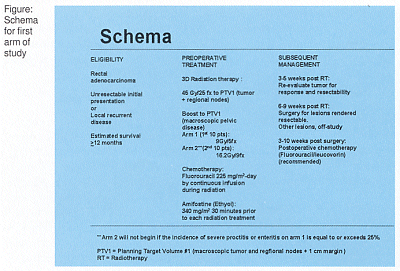Can Concurrent Amifostine and 5-FU Permit Delivery of Higher Boost Doses of Radiation?
ST. LOUIS-Soon to be launched is a trial to determine if amifostine (Ethyol) with concurrent infusion of 5-fluorouracil will permit delivery of higher boost doses of radiation in unresectable or locally recurrent rectal cancer.
ST. LOUISSoon to be launched is a trial to determine if amifostine (Ethyol) with concurrent infusion of 5-fluorouracil will permit delivery of higher boost doses of radiation in unresectable or locally recurrent rectal cancer.
"Although many patients are cured with a combination of preoperative radiation and surgery, less than 10% achieve a complete response to radiation, and only about 10% to 30% show a complete response to chemotherapy and radiation," said Robert J. Myerson, MD, PhD, explaining the rationale for the trial. "Patients who might benefit from higher preoperative radiation doses include those with locally advanced cancers and unresectable cancers, recurrent cancers, or distal tumors (to facilitate sphincter preservation)." Dr. Myerson is professor of radiology at Washington University School of Medicine in St. Louis.
Acute Toxicity
One strategy to improve response is to increase radiation dose. With concurrent chemotherapy, however, the rectal and small bowel tolerance limits the rectal dose to about 55 Gy, according to Dr. Myerson. "The hope is that a radioprotectant may permit dose intensification," he said.
"Acute toxicity in rectal cancer during preoperative chemoradiotherapy is substantial enough to be a useful endpoint in a radioprotectant trial," he noted. "With preoperative radiotherapy alone, the grade 3 or 4 acute rectal or small bowel toxicity rate is less than 10%. It rises to 20% to 30% with combined chemotherapy and radiation. Perioperative toxicity and late toxicity are both 10% to 15% with or without chemotherapy.
Dr. Myerson said that with most regimens of preoperative radiation, generally about 45 Gy, and 5-FU based regimens, acute grade 3 or worse morbidity occurs in 20% to 49% of patients. "The pathologic complete response for chemotherapy and radiation is better than with radiation alone, but it is still only about 30%. That’s not high enough to avoid proctectomy in most cases," he said.
Addition of Amifostine
The new trial is intended to determine if the addition of amifostine will permit radiation dose escalation while maintaining objective response rates comparable to or better than historic controls. The study will be driven by efficacy and toxicity endpoints. The toxicity endpoint will be acute small bowel and rectal toxicity during treatment. "We would expect about 60% to 70% objective response and hope to demonstrate that the addition of amifostine preserves tumor response rate while reducing toxicity," Dr. Myerson said.
Eligible patients will have unresectable initial presentation or local recurrence of disease, with no prior radiotherapy. The first arm of the study will be 45 Gy followed by a 9-Gy boost, conventionally fractionated. Patients will get protracted venous infusion of 5-FU and amifostine at 340 mg/m2 half an hour before each radiation treatment.

"If fewer than 25% of patients in arm 1 develop grade 3 or grade 4 acute proctitis and if there is at least a 50% objective response rate, we will proceed to the second arm of the study, which will be 16-Gy boost," Dr. Myerson said. "Everybody will receive standard surgery and standard post-surgical chemotherapy."
"We’ll have between 10 and 20 patients on the first arm of the study. We’ll go to 20 if we get more than two acute toxicities in the first 10. We’ll close the whole study if the first five patients have severe acute proctitis or enteritis,’" Dr. Myerson said. "Ultimately we’re going to need more control of the circumference of the rectum so that final boost volumes can spare the rectum while covering the tumor. I would also like to identify subgroups of patients who consistently achieve better than 50% complete response rates. Ultimately we may be able to offer them something less than a proctectomy."